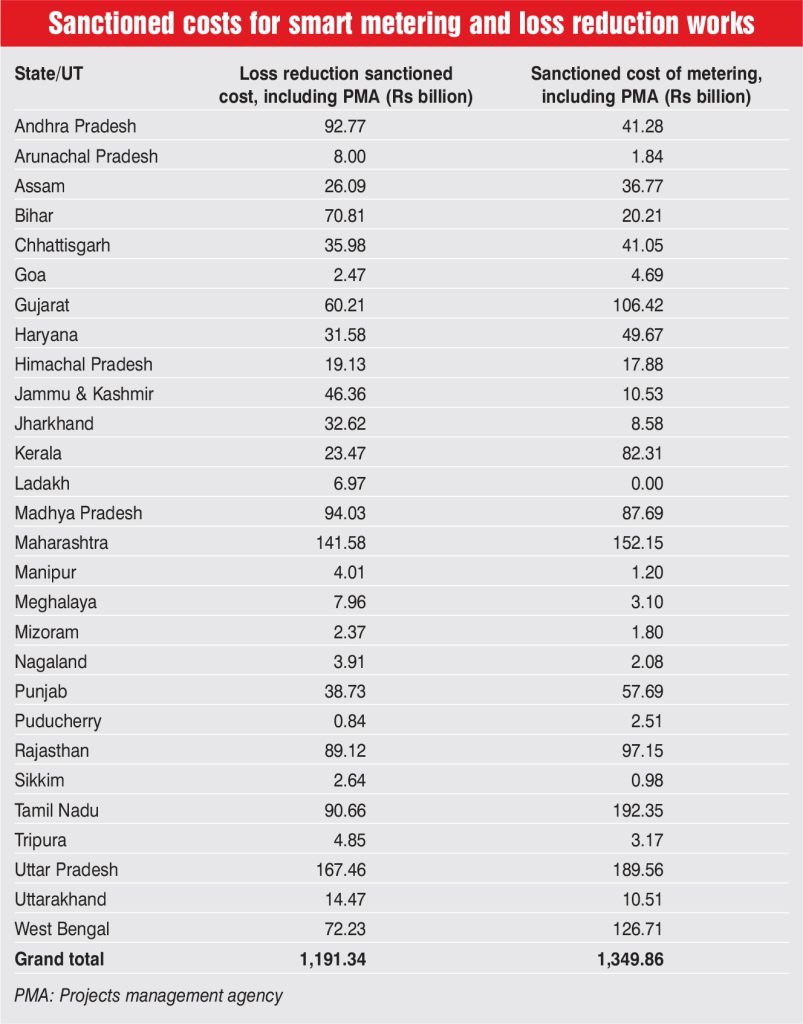Launched in 2022, the Ministry of Power’s (MoP) flagship RDSS initiative aims to improve operational efficiencies and financial sustainability by offering results-linked financial assistance to discoms. This assistance will strengthen the supply infrastructure, contingent upon meeting pre-qualifying criteria and achieving basic benchmarks.
The scheme aims to allocate a total of Rs 3,037.58 billion, including gross budgetary support (GBS) of Rs 976.31 billion, for a period of five years (2021-22 to 2025-26). This financial assistance is intended for modernising and strengthening the distribution infrastructure, enhancing the reliability and quality of supply to end-consumers, and installing smart meters. Tendering activity for smart metering and loss reduction works under the scheme has gained momentum in recent months. Contracts for the implementation of these works have been awarded, raising expectations for tangible progress under the scheme.
Power Line takes a look at the status of the RDSS…
Targets under the programme
The main objectives of the RDSS are to reduce aggregate technical and commercial (AT&C) losses to 12-15 per cent and to eliminate the average cost of supply-average realised revenue (ACS-ARR) gap by financial year 2024-25. Additionally, the scheme aims to address several concerns related to regulations, governance, government support and technological issues in the power distribution segment.
The RDSS is divided into two key components: Part A, which provides financial support for prepaid smart metering, system metering and distribution infrastructure upgrades; and Part B, which focuses on training, capacity building, and other enabling and supporting activities. The sanctioned outlay for smart metering amounts to approximately Rs 1,349.86 billion, while for loss reduction works it is Rs 1,191.34 billion.
A key intervention envisaged under the RDSS is prepaid smart metering, with an estimated outlay of approximately Rs 1,500 billion and a GBS of Rs 230 billion. The scheme aims to install a total of 250 million smart meters by 2025-26. Smart metering projects are planned to be implemented under the design-build-finance-operate-transfer mode through the public-private partnership approach.
In addition to prepaid smart metering for consumers, advanced metering infrastructure and system metering will be implemented at the feeder and distribution transformer levels, equipped with communicating features. Furthermore, the RDSS promotes the adoption of advanced information and communication technologies, such as artificial intelligence and machine learning, to analyse data generated by smart meters and information technology/operational technology devices.
Under the RDSS, capital investment has also been allocated for loss reduction works, system strengthening to accommodate load growth and modernisation required to establish a smart distribution system. Loss reduction works involve replacing conductors with aerial bunched cables, implementing high voltage distribution systems (HVDS), and feeder bifurcation. Similarly, system strengthening involves creating new substations and feeders, upgrading transformation capacity, and improving cable infrastructure. Modernisation efforts include implementing supervisory control and data acquisition, distribution management systems, information technology/operational technology, enterprise resource planning, geographic information system-enabled applications and advanced distribution management systems. These initiatives aim to enhance distribution systems.
To ensure a consistent and uninterrupted supply of electricity to farmers, the RDSS includes provisions for the segregation of agricultural feeders where the agricultural load exceeds 30 per cent. A convergence with the KUSUM programme has also been envisioned. As of now, Rs 299.45 billion has been sanctioned for the segregation of agricultural feeders.
Progress so far
According to a recent Lok Sabha report (March 2023), the utilisation of funds under the scheme during 2021-22, 2022-23 stood at Rs 53.7 billion against the budgeted outlay of Rs 85.65 billion. Under the RDSS, detailed project reports (DPRs) totalling Rs 1,191.34 billion, inclusive of GBS of Rs 758.84 billion, have been sanctioned. Out of the total sanctioned funds, as proposed by state/discoms, Rs 145.09 billion has been sanctioned for districts of every state (excluding Odisha, Karnataka and Telangana) for works such as HVDS implementation, cabling and feeder segregation.

According to a Lok Sabha report (February 2023), 204.62 million prepaid smart meters, 5.41 million distribution transformer meters and 198,826 feeder meters have been sanctioned across 28 states (46 discoms) under the RDSS, for approximately Rs 1.35 trillion. Tenders have been issued for smart metering works, covering approximately 103 million prepaid smart meters for consumer metering, as well as 3.8 million system meters for distribution transformers and feeders. Further, tenders have been issued for distribution infrastructure/loss reduction works amounting to Rs 788.27 billion.
In the past month, several states/UTs have been onboarded to the scheme. These include the NDMC area of New Delhi with a project cost of Rs 3.37 billion, Ladakh with a sanctioned cost of Rs 6.87 billion (including grid connectivity of the Changthang region, downline infrastructure in the Zanskar region and other loss reduction works in Leh and Kargil districts of Ladakh) and Nagaland.

Conclusion
The strategic measures of the RDSS are anticipated to improve the long-term viability of the distribution sector while reducing the ACS-ARR gap and AT&C losses, levels of outstanding subsidy payable by the state government, and outstanding government department dues. Going forward, implementation of the RDSS will be enhanced significantly through prepaid smart metering, enforcement of prequalification conditions and implementation of the results-linked framework.
